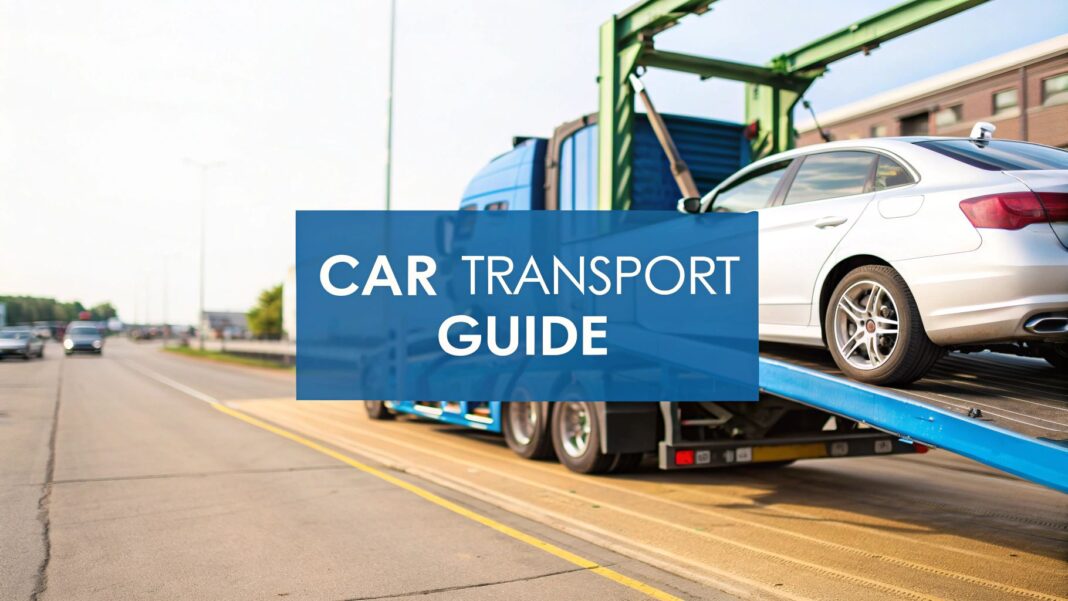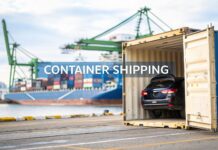
When you need to transport a car, the process boils down to a few key decisions: picking a transport type, vetting a reputable company, and preparing your car for the journey. With the right information and preparation, moving a vehicle—whether to the next state or across the country—can be a straightforward and secure process. This guide provides actionable steps to ensure your car's transport is smooth from start to finish.
Your Guide to a Stress-Free Car Transport

Shipping a vehicle for the first time can seem complex, but it's a manageable task when broken down. The core objective is getting your car from Point A to Point B safely. Your role is to make informed choices before the car is loaded onto a truck, balancing cost, convenience, and the level of protection your vehicle requires.
This guide is your roadmap. We'll transform what appears to be a complicated undertaking into a series of clear, actionable steps. The initial decisions you make are the most critical, setting the stage for the entire experience.
The Core Decisions in Car Transport
One of the first practical decisions is selecting the type of carrier that will transport your vehicle.
- An open carrier is the industry standard and the most cost-effective option. These are the multi-car haulers commonly seen on highways delivering vehicles to dealerships. For most standard cars, this method is perfectly sufficient and reliable.
- An enclosed carrier provides complete protection from weather, road debris, and potential theft. This premium service is the recommended choice for transporting classic cars, luxury models, or any high-value vehicle that requires extra care.
You will also need to decide whether to work directly with a carrier (the company owning the trucks) or a broker. A broker acts as an intermediary, connecting you with a network of vetted carriers to find the best match for your route and timeline. We'll explore the pros and cons of each to help you determine the most effective approach for your needs.
The car transport industry is a significant part of the global economy. Valued at around $12 billion annually, its growth is driven by the rise of online car sales and corporate relocations. This is a well-established, essential service, not a niche market. You can explore car transportation market growth trends for more details.
By understanding these foundational choices, you can effectively navigate the process, avoid common pitfalls, and ensure your vehicle is handled professionally.
Picking the Right Transport Method and Company
Once you've decided to ship your car, the next step is selecting how it will be shipped and who will do the job. This decision directly impacts your budget, timeline, and the safety of your vehicle during transit. Getting this step right is crucial for a successful transport experience.
Open vs. Enclosed: What's Right for Your Car?
The two primary methods for shipping a vehicle are via open or enclosed carrier. Your choice should be based on your vehicle's value, your budget, and your desired level of protection.
An open carrier is the most common and economical method. These large, often two-level trucks are the workhorses of the industry, moving the majority of vehicles across the country. For a standard sedan, SUV, or daily driver, an open carrier offers a reliable and affordable solution.
An enclosed carrier is the premium, white-glove service. Your vehicle is transported inside a sealed trailer, completely shielded from weather, road debris, and public view. This is the optimal choice for classic cars, exotic sports cars, high-end luxury vehicles, or any car where preserving a pristine condition is paramount.

The primary trade-off is cost versus protection. Enclosed transport can be 50-100% more expensive than open transport, but you are paying for a superior level of security and peace of mind.
To make an informed decision, consider this direct comparison.
Comparing Open vs Enclosed Car Transport
Use this table to decide which transport method best suits your vehicle, budget, and protection needs.
| Feature | Open Transport | Enclosed Transport |
|---|---|---|
| Cost | More affordable, the industry standard. | Premium pricing, often 50-100% more expensive. |
| Protection Level | Exposed to weather and road debris. | Fully protected from all external elements. |
| Best For | Daily drivers, standard sedans, SUVs. | Classic cars, luxury vehicles, race cars, exotics. |
| Availability | Widely available, easier to schedule. | Fewer carriers, may require more booking flexibility. |
| Driver Experience | Drivers are skilled with all standard vehicles. | Drivers often specialize in high-value vehicles. |
Ultimately, weigh your vehicle's value against your budget to make the most practical choice.
Brokers vs. Carriers: Who Should You Call?
After selecting a transport type, you'll choose between working with a transport broker or directly with a carrier.
- Carriers own the trucks and employ the drivers. Booking with a carrier means you deal with one company for the entire process.
- Brokers are logistics specialists with access to a large, pre-screened network of carriers. A reputable broker can often find a carrier for your route more quickly and efficiently than you could on your own.
Many of the most reliable companies in the industry are brokers, valued for their flexibility and extensive reach. The critical factor isn't choosing between a broker and a carrier, but selecting a reputable and trustworthy company. To learn more about the logistics, our guide on how car shipping works provides a detailed breakdown.
How to Vet Any Transport Company
Regardless of who you consider, thorough due diligence is essential. The auto transport industry is vast, and a few minutes of research can prevent scams, delays, and unnecessary stress. The demand is huge, with global car sales projected to hit nearly 50 million units in 2025, and the U.S. accounting for 19% of that market, creating a constant need for reliable shipping.
Follow this checklist before signing any contract:
-
Check Their Credentials. All legitimate interstate transport companies must be registered with the Federal Motor Carrier Safety Administration (FMCSA). Ask for their MC (Motor Carrier) or DOT (Department of Transportation) number and verify it on the official FMCSA website. This confirms their legal status and allows you to review their safety record.
-
Read Recent Reviews. Look beyond star ratings. Analyze recent customer feedback on Google, the Better Business Bureau (BBB), and transport-specific review sites. Consistent praise for clear communication and on-time service is a positive indicator, while repeated complaints about hidden fees or unresolved issues are major red flags.
-
Verify Their Insurance. Never assume your car is covered. Request a copy of their insurance certificate. You need to understand the coverage limits, what types of damage are covered, and if there's a deductible you would be responsible for in the event of a claim.
Pro Tip: Be wary of quotes that are significantly lower than the competition. An unusually low price is a classic tactic for a "bait-and-switch," where additional fees are added after you've committed. A professional company provides a transparent, all-inclusive quote from the start.
Taking these steps ensures you partner with a credible company, giving you confidence that your vehicle is in capable hands.
Getting a Real Price: How to Secure an Accurate Quote and Dodge Hidden Fees

Getting a car shipping quote is easy; getting an accurate one requires understanding the factors that influence the price. The initial number is an estimate, and providing detailed information is the best way to avoid surprise charges. The final cost is a calculation of the logistics required to transport your specific vehicle on your specific route.
What Really Drives Your Car Shipping Cost
The final price is determined by the resources needed for your shipment. It's a custom service price, not a flat rate, primarily based on three factors.
- Your Vehicle's Size and Weight: A large SUV or heavy-duty truck occupies more space and adds more weight to a carrier than a compact sedan. This increased footprint and fuel consumption directly translate to a higher shipping cost.
- The Route and Distance: A cross-country trip from Miami to Seattle will cost more than a regional move from Dallas to Houston. However, it's not just about mileage. Routes along major interstates like I-95 are generally less expensive than transport to remote, rural locations that require the driver to deviate significantly from main corridors.
- The Time of Year: The car shipping industry has peak seasons. Summer and holidays experience higher demand, which can increase prices. If your schedule is flexible, shipping during the off-season (e.g., late fall or winter, avoiding holidays) can often result in cost savings.
These three elements form the basis of every quote. For a more detailed financial breakdown, see our guide on how much it costs to ship a car to another state.
How to Spot Red Flags and Hidden Fees
While a low price is appealing, an exceptionally low quote is often a red flag in this industry. It can signal a "bait-and-switch" tactic, where hidden fees are added later.
A reputable transport company aims to provide a realistic, all-inclusive quote from the outset. The goal should be to find a fair price that ensures a reliable, professional driver will accept and transport your vehicle in a timely manner.
To protect yourself, be aware of these potential hidden fees:
- Fuel Surcharges: The cost of fuel should be included in your initial quote, not added as a separate charge later.
- Insurance Deductibles: Ask upfront if you are responsible for a deductible in the event of a claim. A transparent company will disclose this information.
- Inoperable Vehicle Fees: If your car does not run, it requires a winch for loading and unloading. You must declare this when booking to receive an accurate quote that includes this service fee.
- Storage Fees: If you are unavailable to receive the car upon arrival, storage fees may apply. Clarify the delivery window and any potential charges for delays.
Your Quote Comparison Checklist
To make an informed, apples-to-apples comparison, ask these critical questions before booking:
- Is this quote all-inclusive? Get written confirmation that the price includes all costs—fuel, basic insurance, and fees.
- Can I see your insurance certificate? Request a copy of their insurance policy to verify coverage limits and any deductible.
- What’s the payment schedule? Understand when payments are due. A common practice is a small deposit to book, with the balance paid upon delivery (often in cash or certified funds) to the driver.
- What is the realistic transit time? Get a clear delivery window, but understand it is an estimate. Weather, traffic, and other logistical factors can cause delays.
- Who is my point of contact during transit? Know who to call for updates while your car is on the road.
Asking these questions empowers you to make a confident decision, ensuring the price you agree to is the price you pay.
Getting Your Vehicle Ready for a Safe Trip
Proper preparation of your vehicle is a critical step for a smooth auto transport experience. This isn't just a checklist; it's a proactive measure to protect your car, streamline the handover process, and prevent potential disputes. By taking these actions, you make the process easier for both yourself and the transport driver.
Clean It Up and Get Your Camera Out
Start by thoroughly washing your vehicle. A clean car allows for an accurate inspection, making it easy to see and document every existing ding, scratch, or scuff. This is not about aesthetics; it's about creating an undeniable record of the car's condition before it is loaded. If you need guidance, here's the best way to wash your car at home for a flawless finish to ensure no imperfection goes unnoticed.
After cleaning, document the car's condition with time-stamped photos and videos. Capture every angle—front, back, sides, roof, and interior. Take close-up shots of any pre-existing damage, no matter how minor. This visual evidence will be invaluable if a claim needs to be filed later.
Empty Your Car Completely
Resist the temptation to use your car for extra storage. The carrier's insurance covers your vehicle only, not personal belongings left inside. Items like electronics, clothing, or tools that are lost, damaged, or stolen during transit will not be compensated.
Furthermore, personal items add weight. Transport trucks must adhere to strict weight limits set by the Department of Transportation (DOT). An overweight vehicle can lead to fines and delays for the carrier. The rule is simple: remove all personal items. This includes loose change, phone chargers, sunglasses, and toll transponders (like an EZ-Pass).
It is non-negotiable to remove all personal items. While some carriers may permit up to 100 lbs in the trunk, the safest and most compliant action is to ensure the car is completely empty. This eliminates liability disputes and accelerates the pickup inspection.
The Final Mechanical and Exterior Checks
A few final mechanical and exterior checks will prevent delays and facilitate a smooth loading process.
- Fuel Level: Do not fill the gas tank. A full tank adds unnecessary weight. A quarter tank of fuel is sufficient for the driver to load, unload, and maneuver the vehicle.
- Fluid Leaks: Check under the car for any active leaks. If you notice a minor drip, inform the carrier and driver. An undisclosed major leak is a serious safety issue, as fluids could drip onto and damage other vehicles on the carrier.
- Tire Pressure: Ensure all tires, including the spare, are properly inflated. This makes the vehicle easier to move during loading and unloading.
- Battery Charge: The vehicle must be able to start for the driver to load it. Confirm the battery is fully charged. If the battery is unreliable, notify the transport company in advance.
Finally, conduct a last walk-around to secure any loose exterior parts. Retract or remove custom antennas, fold in side mirrors, and ensure spoilers or body kits are securely fastened. These simple actions help prevent accidental damage during transport.
For insights on how this compares to transporting other large items, see our guide on what you should know about boat and car transport.
Making the Pickup and Delivery Go Smoothly

The pickup and delivery days are the most critical moments in the transport process. Understanding what to expect and what your responsibilities are will ensure a seamless handover. The entire process revolves around a single, vital document: the Bill of Lading (BOL). This is not just a receipt; it is your legal contract with the carrier and the official inspection report that documents your car's condition before and after transit.
The All-Important Pickup Inspection
When the driver arrives, they will conduct a detailed walk-around inspection of your car. You must be present for this. This is your opportunity to agree on the vehicle's condition before it is loaded onto the truck. Do not rush this step.
The driver will note every scratch, dent, and imperfection on the BOL. Your role is to actively participate, comparing their notes against the photos you took earlier. If you see an existing chip that they missed, point it out and ensure it is added to the report.
Actionable checklist for a successful pickup:
- Be Present. If you cannot be there, designate a trusted representative who understands the importance of the inspection.
- Verify the BOL. Confirm that all information—your name, addresses, and vehicle details—is 100% accurate.
- Confirm All Damage is Marked. The vehicle diagram on the BOL should accurately reflect all pre-existing imperfections.
- Sign Only When You Are Satisfied. Your signature confirms your agreement with the condition report. At this point, the carrier assumes liability for the vehicle.
A thorough and accurate BOL at pickup is your primary tool for protecting your investment.
Keeping Tabs on Your Car in Transit
Once your car is en route, you will want to track its progress. Most reputable transport companies offer a method for doing so, whether through a GPS tracking link, direct contact with the driver, or updates from a dispatcher.
The need for vehicle logistics continues to grow. The global vehicle fleet is expected to reach 1.644 billion by 2025, a 21.8% increase in just five years. This growth highlights the essential role of reliable car transport services. You can find more data in these global vehicle ownership statistics on autokunbo.com.
A Quick Word on Timing: Remember that carriers provide a delivery window, not a fixed appointment. Factors like weather, traffic, and other pickups/deliveries can affect the schedule. Maintain communication with your driver or dispatcher for the most accurate ETA.
The Final Inspection at Delivery
Upon arrival, you will repeat the inspection process. This final check is crucial. Before signing the BOL or making the final payment, conduct a thorough inspection of your vehicle.
Inspect the car in good lighting. If it arrives at night, move it into a well-lit area. With the driver present, carefully walk around the vehicle. Use your copy of the BOL and your "before" photos to compare the car's current condition to the report from pickup. Examine every panel, the roof, glass, and bumpers.
What to Do if You Find New Damage
While uncommon, new damage can occur. If you discover a scratch or dent that was not noted on the original BOL, it is vital to address it immediately and correctly.
- Remain Calm. This is precisely why carriers are required to have insurance.
- Take Photos. Document the new damage with clear photos from multiple angles.
- Note it on the BOL. This is the most critical step. Before signing, write a clear description of the new damage directly on the Bill of Lading.
- Get the Driver's Signature. The driver must sign the updated BOL to acknowledge that the damage was noted at delivery. This creates the official record needed to file a claim.
Only after you have documented any issues should you proceed to the final step.
Settling Up
After completing the inspection, the final step is to pay the remaining balance to the driver. Most drivers accept cash, a cashier's check, or a money order. Personal checks and credit cards are rarely accepted on-site, so confirm the required payment method in advance and have it ready.
Once payment is complete and you have signed the final Bill of Lading, the process is finished. Your diligence during pickup and delivery has ensured a successful and accountable transport of your vehicle.
Your Top Car Shipping Questions, Answered
Even with a detailed plan, questions are inevitable when entrusting a valuable asset to a transport service. Here are clear, actionable answers to the most common concerns.
What’s the Real Cost to Ship a Car?
There is no flat rate for shipping a car; the final cost depends on several variables. A short, state-to-state transport might cost around $600, while a coast-to-coast shipment can be $2,000 or more.
The primary factors are distance and vehicle size. A large truck like a Ford F-150 costs more to ship than a Honda Civic because it takes up more space and weight. The choice between a standard open carrier and a premium enclosed trailer also significantly impacts the price. Finally, shipping during peak seasons, such as summer, typically costs more due to higher demand.
As a practical example, shipping a standard sedan from Chicago to Phoenix on an open carrier generally costs between $1,100 and $1,400.
Is My Vehicle Insured During Transport?
Yes. Federal regulations require all licensed auto transport carriers to maintain cargo insurance that covers damage caused by their negligence during transit.
Before booking, always request a copy of their insurance certificate. This document details the coverage limits and specifies whether a deductible applies in the event of a claim. It is essential to understand that this insurance covers the vehicle only, not any personal items left inside. For high-value classic or luxury cars, you may consider purchasing supplemental insurance for complete coverage.
The carrier's insurance is your safety net for damages that occur due to their actions, such as an accident during loading. It does not cover pre-existing mechanical issues or coincidental failures that may arise during the trip.
How Long Until My Car Arrives?
Transit time is primarily determined by distance. A regional transport, such as from Atlanta to Miami, typically takes 2-4 days. A cross-country journey from New York to California will usually take 7-10 days.
It is important to understand that transport companies provide a delivery window, not a precise appointment. The driver manages a full load of vehicles, and delays due to weather, traffic, or mechanical issues can occur. Plan for some flexibility in your schedule and maintain communication with the driver for the most current ETA.
Can I Pack My Car with Personal Stuff?
The answer is almost always no. Transport companies strictly prohibit packing personal items in vehicles for several important reasons:
- No Insurance Coverage: The carrier’s insurance does not cover personal belongings. If items are lost, damaged, or stolen, you have no recourse.
- DOT Weight Limits: Trucks have strict weight limits. The accumulated weight of personal items can result in fines and transport delays.
- Safety Hazards: Unsecured items can shift during transit, potentially damaging your car's interior or becoming projectiles during loading and unloading.
While a few carriers may permit up to 100 lbs secured in the trunk, the safest and recommended practice is to ship all personal belongings separately.
What If My Car Doesn’t Run?
You can ship an inoperable vehicle, but you must inform the transport company when you request a quote.
A non-running car requires a truck equipped with a winch to be loaded onto the carrier. This specialized service involves extra labor and equipment, incurring an additional fee, typically between $150 and $300. Disclosing the car's condition from the outset is the only way to get an accurate quote and ensure the correct type of truck is dispatched for pickup. For other general car-related questions, you may find their FAQ guide useful.
When you need to transport a car with confidence, trust the experts who manage every detail. At We Will Transport It, we combine over a decade of experience with a commitment to transparent pricing and reliable service. Whether you're moving a family car, a classic vehicle, or heavy equipment, our team is ready to ensure a safe and timely delivery. Get your free, no-obligation quote today and discover how easy shipping can be. Schedule your transport with us.
Article created using Outrank





